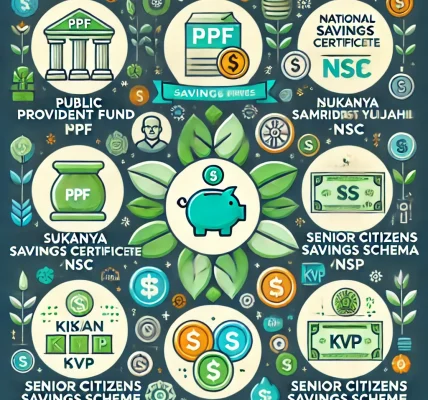Introduction
Government-backed savings schemes are among the safest investment options for individuals looking to secure their financial future. These schemes offer guaranteed returns, tax benefits, and long-term financial security. However, they also come with certain limitations. This guide will explore the advantages and disadvantages of various government-backed savings schemes to help you make an informed decision.
What Are Government-Backed Savings Schemes?
These are financial products initiated and managed by the government to encourage savings and investment among individuals. They cater to different financial needs, such as retirement planning, child education, and tax savings.
Top Government-Backed Savings Schemes in India
1. Public Provident Fund (PPF)
- Pros:
- Risk-free investment with government backing.
- Attractive interest rates (~7-8%).
- Tax-free interest and maturity amount.
- 15-year lock-in ensures disciplined savings.
- Cons:
- Long lock-in period with limited liquidity.
- Fixed interest rate, lower than equity-based investments.
2. National Pension System (NPS)
- Pros:
- Helps in retirement planning.
- Additional tax benefits under Section 80CCD(1B).
- Market-linked returns, often higher than fixed-income instruments.
- Cons:
- Lock-in until retirement, limiting early withdrawals.
- Annuity purchase is mandatory at maturity.
- Returns are not entirely tax-free.
3. Senior Citizens Savings Scheme (SCSS)
- Pros:
- Exclusive for senior citizens (60+ years).
- Attractive interest rates (~8-8.5%).
- Government-backed, ensuring security.
- Cons:
- Interest is taxable.
- Premature withdrawal attracts penalties.
- Maximum investment limit of ₹30 lakh.
4. Sukanya Samriddhi Yojana (SSY)
- Pros:
- High-interest rates (~7-8%).
- Tax-free returns under Section 80C.
- Designed for securing a girl child’s future.
- Cons:
- Limited to a girl child, not applicable for everyone.
- Funds are locked until the child turns 21, with limited withdrawal options.
5. Post Office Monthly Income Scheme (POMIS)
- Pros:
- Fixed monthly income from savings.
- Government-backed, ensuring safety.
- Ideal for retirees or those needing stable returns.
- Cons:
- Interest is taxable.
- Lower returns compared to market-linked options.
6. Kisan Vikas Patra (KVP)
- Pros:
- Doubles investment over a fixed tenure (~10 years).
- No upper limit on investment.
- Safe, government-backed.
- Cons:
- No tax benefits.
- Fixed interest rate, which may not beat inflation.
7. Employee Provident Fund (EPF)
- Pros:
- Tax-free returns.
- Employer contribution boosts savings.
- Ideal for salaried individuals.
- Cons:
- Withdrawals restricted before retirement.
- Employees cannot control how funds are invested.
How to Choose the Right Scheme?
Consider these factors before selecting a savings scheme:
- Investment Goals – Retirement, tax-saving, education, or monthly income.
- Lock-in Period – Can you keep your funds invested for the required duration?
- Tax Benefits – Look for schemes offering deductions and exemptions.
- Liquidity Needs – Some schemes have strict withdrawal rules.
- Risk Tolerance – Government schemes are safe but may offer lower returns.
Conclusion
Government-backed savings schemes are a great way to secure your financial future with minimal risk. However, they may not always provide the highest returns compared to market-linked investments. A well-balanced portfolio combining government-backed savings with equity-based investments can help maximize returns while ensuring financial security. Choose wisely based on your financial goals and liquidity needs.



